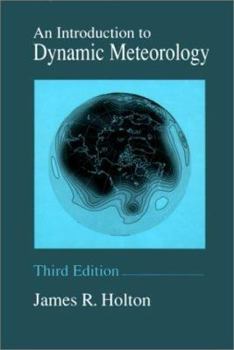An Introduction to Dynamic Meteorology
(Book #88 in the International Geophysics Series)
Select Format
Select Condition 
Book Overview
This revised text presents a cogent explanation of the fundamentals of meteorology, and explains storm dynamics for weather-oriented meteorologists. It discusses climate dynamics and the implications... This description may be from another edition of this product.
Format:Hardcover
Language:English
ISBN:012354355X
ISBN13:9780123543554
Release Date:April 1992
Publisher:Academic Press
Length:511 Pages
Weight:1.85 lbs.
Dimensions:1.1" x 6.3" x 9.3"
Customer Reviews
5 ratings
predictor for one's success in atmospheric sciences
Published by Thriftbooks.com User , 14 years ago
I was trained in a classical program in atmospheric sciences in the sense that the atmosphere is a fluid hence the field being a sub-discipline of fluid mechanics is much emphasized. Holton's book is The Undergraduate Textbook for programs rooted in this understanding, in the US or internationally. As an undergrad I was told that whether or not I was meant to stay in this field could be predicted by how well I performed in the class teaching Holton. Now one of my duties is to teach dynamics to undergraduates in atmospheric sciences at a US land-grant university. I am however disappointed to find out that most students coming to the dynamics class do not have such understanding. There is a tendency for students to forsake the hard-core atmospheric sciences in favor of the marginal science in broadcasting meteorology. Holton's book is often not tolerated and considered too 'mathematical' (this happens to be the most common excuse students without any originality would use). I really would like to challenge the students who have shunned (or plan to shun) Holton's book to think twice about how serious they are in pursuing a career in atmospheric sciences before they make fair judgments about the value this book.
Extraordinarily good text
Published by Thriftbooks.com User , 17 years ago
I have to say I'm not sure if texts on atmospheric dynamics get better than this. Physics books in general, in fact, rarely provide an understanding of phenomena that is so concise, intuitive, and yet mathematically robust. I highly recommend it for children, as a gift, and for pleasure reading. I also very seriously recommend it as a graduate textbook. Five stars all the way.
The most exellent textbook in dynamics of the atmopshere
Published by Thriftbooks.com User , 17 years ago
This book, in my opinion, is the most valuable book on dynamical aspects of the atmosphere insofar, especially from pedagogical point of views. As a foreign student, I understand well Holton's writings. Simple but very concise sentences, no wordy explanations. The first 3 chapters provide you the basic equations used in meteorology and their common approximations. The next 5 chapters, to me, are the most interesting chapters. They give you wide range of knowledge from boundary layer, synoptic scale phenomena, to instabilities. Equations are of great usefulness because THEY bring into the light physical contents of the dynamics of the atmosphere. To me, any analytical equation and its explicit solution provide us a more complete understanding than numerical models do (because you never know some unpredictable behaviour of numerical solutions). So, try to understand carefully the simplest cases that Holton selected. This gives you a lot of deeper understandings. Chapters 9 to 11 provide the dynamics of meso- to large-scale circulations. You will see why the Hadley circulation descends around 35N in very clear way. However, simple Poisson eqn with the argument of "positive forcing, negative solution" that is applied throughout the text should be paid especial attention because this conclusion is not always true. As a whole, the contents, explanations and derivations will be very well constructed if you see the main point of each section. To get to the heart of this book, read and derive all the skips in Holton's derivations. The gaps are not too hard to fill out in math but require some thinking. DO ALL OF THE EXERCISES at the end by yourself and you will double your knowledge. For any math-related physical book, transparent derivations are the first thing you should figure out, physical explanations will follow subsequently. From my experience, people tend to skip any chapter what they thought they knew it already. If you apply this method here, you may be in trouble. Read carefully the first 5 chapters, understand approximations used in the each situation. Simply apply equations without judgments of their assumptions will take you into the nightmare. I give this book 5 stars +. It is really classic....
you can't find an alternative.
Published by Thriftbooks.com User , 18 years ago
when i was a student, i used to think, like many other reviewers, that the book is extremely dry. but now as a researcher in atmospheric-oceanic dynamics, i realise that the book is useful in explaining the most essential and elementary theories behind the dynamics one can encounter in meteorology or climate dynamics. use the book as a reference and revision of elementary concepts. if you encounter a process you need to understand in your research, this is the book which will tell you the basics. then you go on and learn more from journal articles and your own research. this new edition of the book, especially with the matlab models, makes studying with it more fun because you can visualise the dynamics and play with the m-files yourself.
Paramount
Published by Thriftbooks.com User , 21 years ago
Useful introduction to dynamic meteorology. Covers many fundamental concepts and concisely. It is not a good fluid dynamics book. It is developed for the atmospheric scientist. It contains an exceptional chapter on waves. Also, there are some elementary concepts related to stratospheric dynamics and general circulation that are very well-written.




